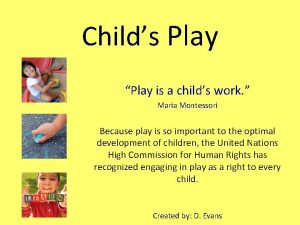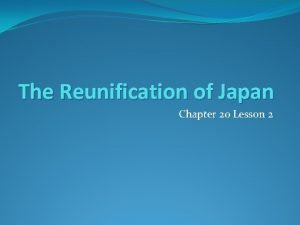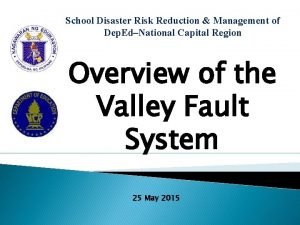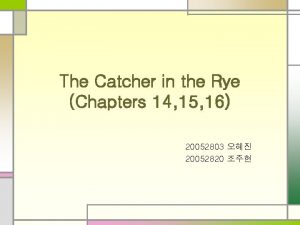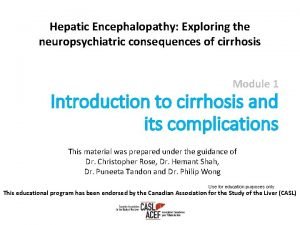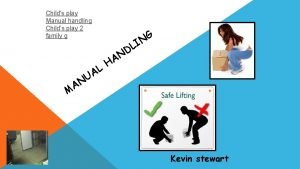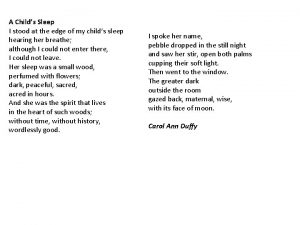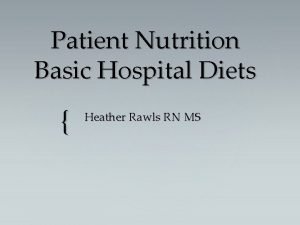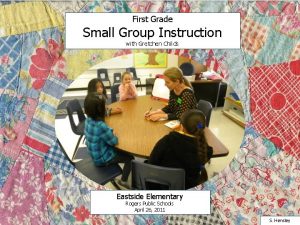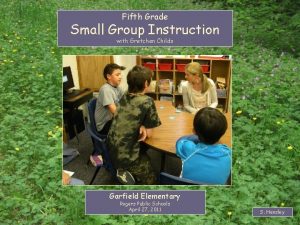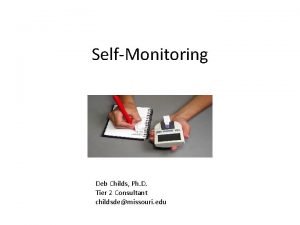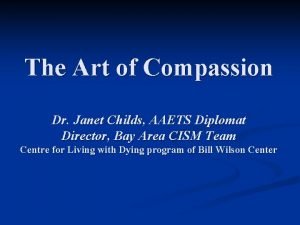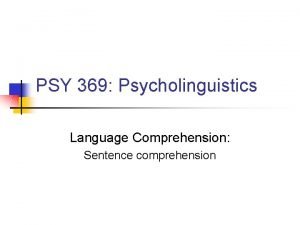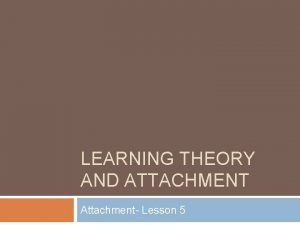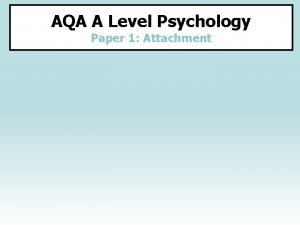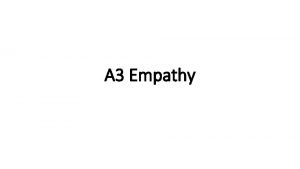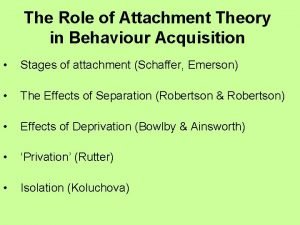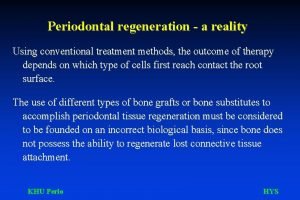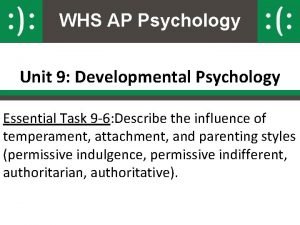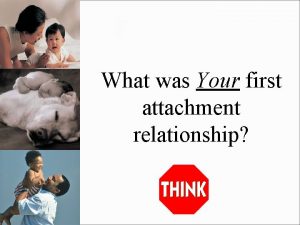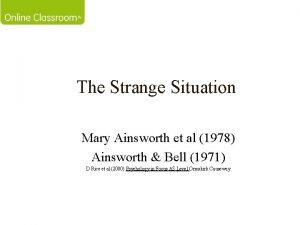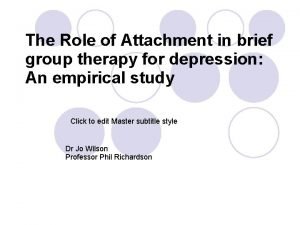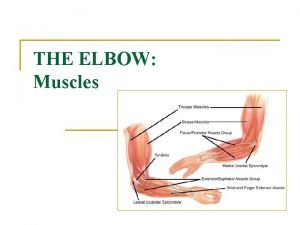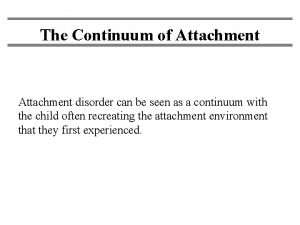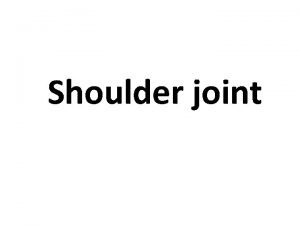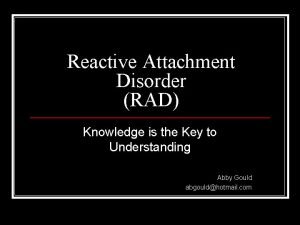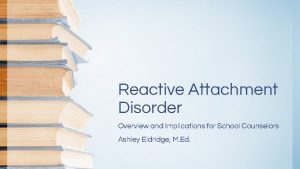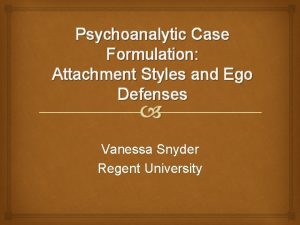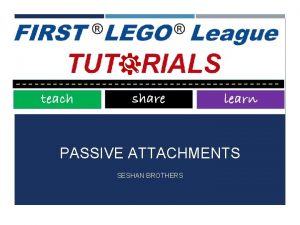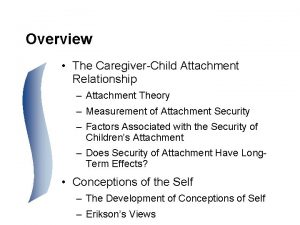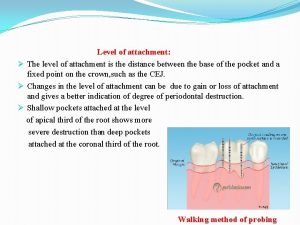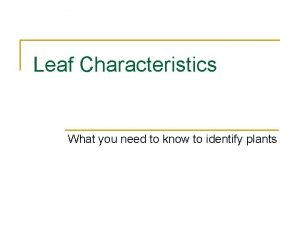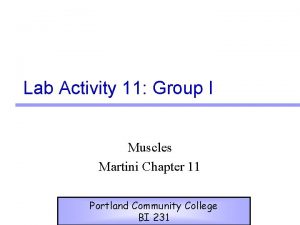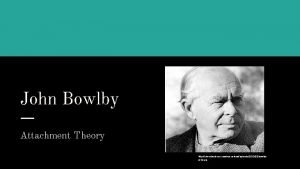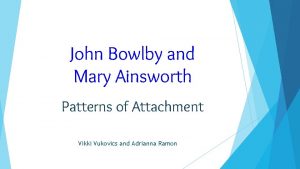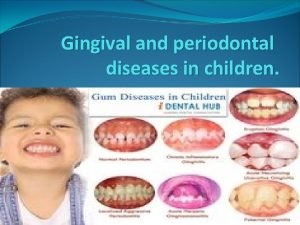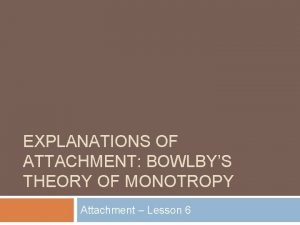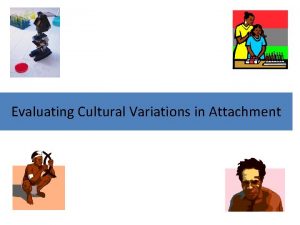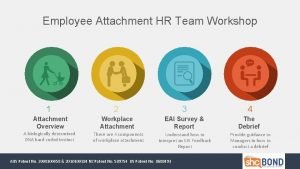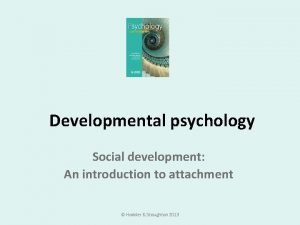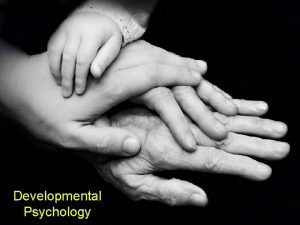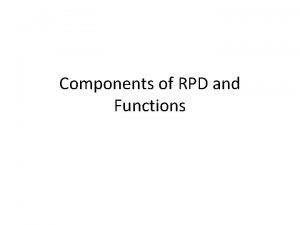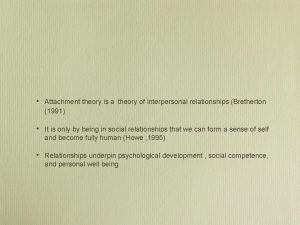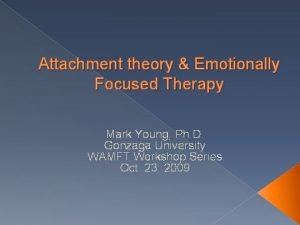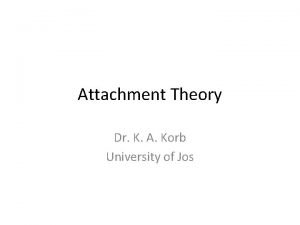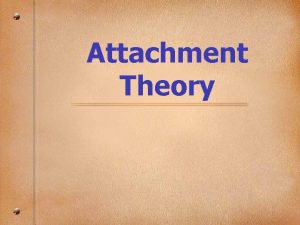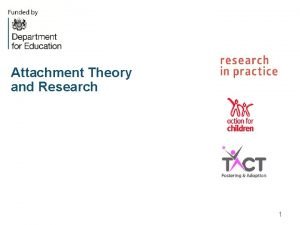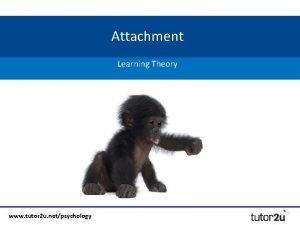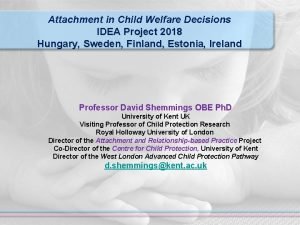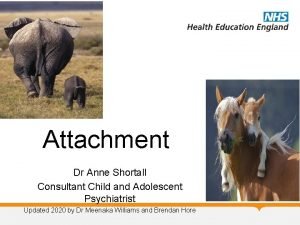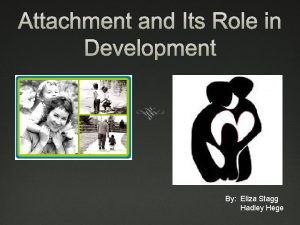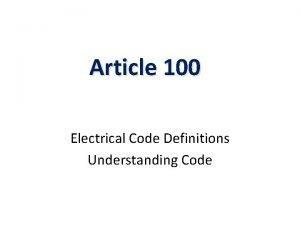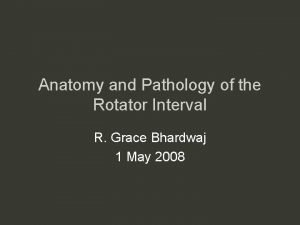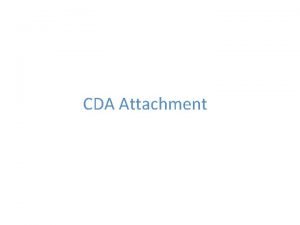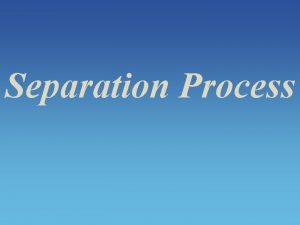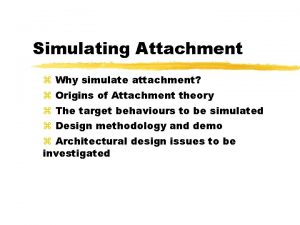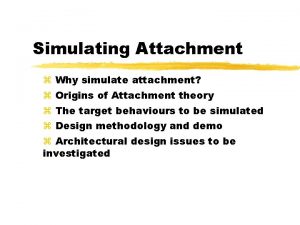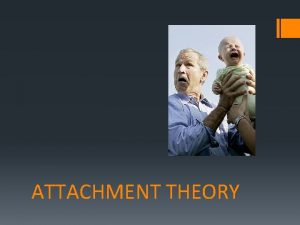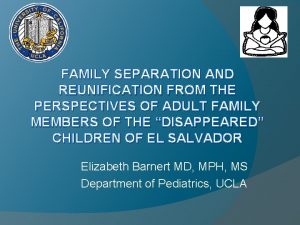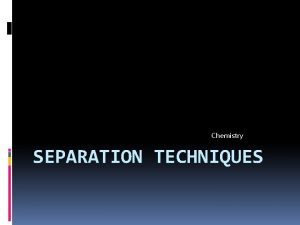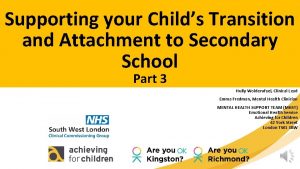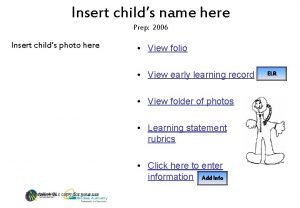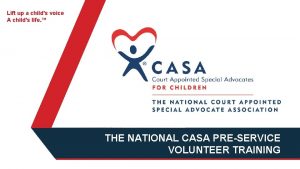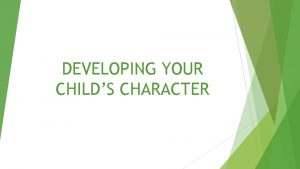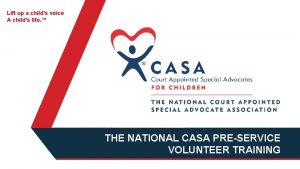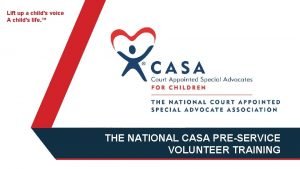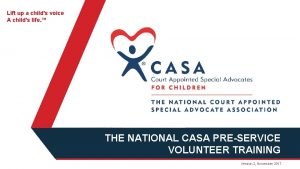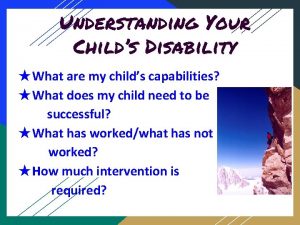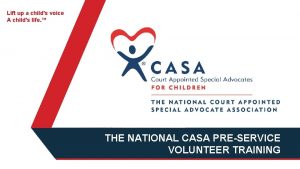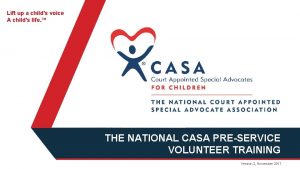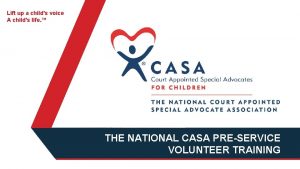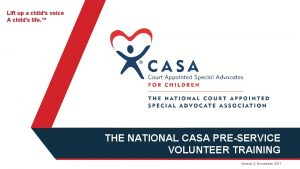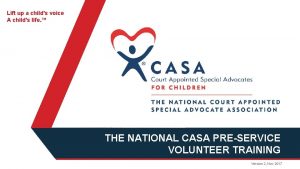Separation reunification and separation A childs attachment to



































































- Slides: 67

Separation, reunification and separation: A child’s attachment to his/her foster carers Dr Janet Haines

Overview Attachment and attachment theory Removing children from parents What happens to children in foster care The process of reunification

Attachment and attachment theory

Human need for attachment Human beings born dependent on others Driven to engage in behaviours that elicit care from caregivers Caregivers are driven to respond to these behaviours Essential for survival

What is attachment? Definition State or quality of one person’s connection to a significant other person Healthy attachment Characterised by: Warmth Intimacy Continuity

Attachment theory Used to explain how infants attach or bond to adults Predominantly developed by John Bowlby in 1930 s and 1940 s

Early conceptualisation Attachment theory Based on notion that deprivation of maternal care would lead to detrimental effects for the child Emotional Social Physical Intellectual Believed separation from mother up to 5 years would result in compromised childhood development

Early conceptualisation Problems with this view Observations only of children exposed to institutional care; or Frequent changes in person primarily offering care Serious methodological limitations Resulted in and continue to result in: Misinterpretations about the nature of attachment Misinterpretations about the risks associated with separation Devaluation of the role of the child’s father or other caregivers

What does this mean? Children do experience a sense of loss and emotional pain when permanently separated from an attachment figure Not the case that a child will suffer only if separated from mother Loss felt if separated from any person with whom they are strongly attached Close caregiver-infant relationship must exist for a child’s needs to be met The caregiver to whom the child becomes attached may be female or male, related to unrelated

Attachment behaviours What are attachment behaviours? Behaviours by a child that ensure attachment relationship features: warmth, intimacy, continuity A child cries and reaches for a caregiver The parent responds by making themselves available Parent comforts the child A sense of closeness is strengthened Attachment behaviours ensure strength and quality of caregiver-child relationship

Caregiver-child relationship The nature of the caregiver-child relationship is important Should provide a psychological environment in which a child can regulate behaviour and emotions Especially when under stress So attachment should serve a stress reduction function Allows a child to feel secure when under pressure

Caregiver-child relationship A child feels secure because of three important features of attachment It fosters behaviours that result in the attachment figure being drawn to the child The provision of a secure base by the attachment figure for the child Separation protest

Separation from attachment figure A securely attached child should be able to separate Crying on separation is an attachment behaviour Not an indication of maladjustment A securely attached child should settle quickly after separation

Parent-child relationships Considerable individual differences These differences occur in relation to factors such as: Parental sensitivity to the child’s needs The ways in which parents respond to the child’s separation protests Child’s attachment seeking behaviours at the time of separation

The nature of the differences Typically viewed as categorical A number of discrete attachment styles Initially thought there were three basic styles Secure Avoidant Anxious-ambivalent

Attachment styles Securely attached children Confidently explore their environment Show no enduring distress on separation Calm down reasonably quickly when distressed Tolerate the presence of strangers Can be comforted by a stranger in the absence of the attachment figure

Attachment styles Children with an avoidant attachment style Indifferent to caregiver’s presence Explore their environment in an indifferent or superficial way Tend to treat a parent or stranger in a similar way

Attachment styles Children with an ambivalent-anxious style Easily upset Distressed when caregiver absent Difficult to comfort even if caregiver returns Tend to display ambivalence when comfort is provided Difficult to manage their feelings of anxiety

Attachment styles Another attachment style was later added Disorganised and disoriented attachment style Children with this style Tend to lack a coherent strategy of attachment Tend to lack a coherent strategy for coping with stress Inconsistent pattern of regulating emotions Seem to be disorganised when faced with an unfamiliar environment Inability or severely reduced ability to form close attachments Tend to be indiscriminate about their choice of attachment figures

Attachment styles These four categories standard in research But increasing concern about categorical approach Category versus dimensional debate Attachment is multi-dimensional Linear combination of at least two variables Proximity seeking versus avoidant strategies Angry and resistant strategies

Attachment styles that develop are a representation of the availability of their attachment figure Reflect attachment history If a child learns that responsive care is available, the child learns to count on others to meet their needs If a child experiences rejection or neglect, the child learns they cannot rely on others

How does attachment work? Not a trait construct inherent in the child Emotional connection between child and caregiver Flexible behavioural system Mediated by feelings towards and interactions with others So attachment develops as a result of parental responsiveness to the child’s innate tendency to maintain proximity with a parent in the first year of life

Contributors to attachment Parent or child factors Greatest influence from parental factors A child with a difficult temperament Presents parenting challenges But it is the way the parent responds to the child’s predisposition that will determine the nature of the parentchild relationship An emotionally unstable mother Mother fails to engage in adequate parenting practises Child cannot compensate for the lack of parenting responsiveness So chances of development of an insecure attachment style will increase

Course of attachment Most securely attached children stay securely attached Children who change from secure attachment: Tend to have caregivers who are less available to them Children who change from secure attachment to disorganised: Tend to have experienced a traumatic event Death of a parent Permanent separation from a parent to whom they are attached

Revisiting attachment theory Theory has developed Bowlby made some errors His concept of attachment being monotropic Children form an attachment to a single figure, usually the mother Children have a hierarchy of attachment figures His concept of attachment having a biogenetic basis Infants have a distinctive and biologically pre-programmed set of behaviours that provide a drive to attach to the mother Children can form attachment relationships with people not related to them

What we know Monotropy is erroneous Based on outdated knowledge Biased conceptualisations of modern day realities Fails to take into account Societies where care-rearing is a shared activity Extended family systems Modern day family structures Infants tend to display no attachment-based preference If stressed, infants may turn to mother But preferences change, so attachment hierarchy is not stable

Removing children from parents

Attachment and maltreatment Children who have received inadequate care Still form attachments to caregivers But attachments may be insecure Especially disorganised type Still, at least half (but probably more) children placed in foster care securely attached

Attachment and maltreatment So what does their behaviour suggest? Not a breakdown of behavioural strategy Behaviours represent efforts to organise around harsh or neglecting caregiver behaviour Complex organisation of behaviour designed to cope with inadequate caregiving Attachment style vs. attachment disorder

Attachment disorders Term used indiscriminately Only one attachment disorder in DSM Reactive Attachment Disorder Prevalence is unknown but considered to be quite uncommon

Reactive Attachment Disorder Diagnostic criteria Criterion A Markedly disturbed and developmentally inappropriate social relatedness in most contexts, beginning before age 5 years, as evidenced by either (1) or (2) (1) Persistent failure to initiate or respond in a developmentally appropriate fashion to most social interactions (2) Diffuse attachments

Reactive Attachment Disorder Criterion B Not developmental delay (Mental Retardation) or Pervasive Developmental Disorder Criterion C Pathogenic care as evidenced by at least one of the following: Persistent disregard for the child’s basic emotional needs for comfort, stimulation, and affection (2) Persistent disregard for the child’s basic physical needs (3) Repeated changes of primary caregiver that prevent formation of stable attachments (e. g. , frequent changes in foster care) (1)

Reactive Attachment Disorder Criterion D There is a presumption that the care in Criterion C is responsible for the behaviour in Criterion A (e. g. , the disturbances in Criterion A began following the pathogenic care in Criterion C) Specify type: Inhibited type: If Criterion A 1 predominates Disinhibited type: If Criterion A 2 predominates

Ease of disengagement How easily can children change caregiver Influenced by strength of attachment Influenced by what happens after separation

Ease of disengagement Caution Cannot be assumed very young infants are unaffected by separation At 2 -7 weeks, infants show preference for mother’s face Dependent on opportunity to see mother’s face But very little exposure needed for this preference to be demonstrated Greater the exposure, stronger the preference

Ease of disengagement Caution 4 -6 week old infants show preference for mother’s voice 2 week old breastfed infants can recognise their mother by smell alone By 3 months, can recognise mother’s face from a photograph Dependent on amount of exposure

Ease of disengagement So, within the first few days of life infants can recognise their mother Recognition becomes based on several sensory mechanisms Recognition increases during first year of life Most crucial phase between 6 -9 months This is when cortical circuits develop

What does this mean? The actions we take to protect children from harm can have significant, unintended and negative effects of the children involved.

Children’s foster care experience

Entering foster care Children enter foster care with their own unique: Histories Experiences Strengths Limitations The child’s behaviour and past experiences can contribute to the quality of attachment that forms with foster carers

Entering foster care Some children: Ill-equipped to elicit or respond to sensitive , involved care Prior experience of poor attachment relationship can cause children to reject foster parents So, some children are more difficult to care for than others May result in a poorer foster care experience

Attachment problems revisited If care experiences prior to foster care inadequate, children may present with reduced capacity to attach securely to foster parents 3 types of problematic attachment patterns Non-attached Disordered Disrupted

Attachment problems revisited Non-attached Infants fail to show a preference for an attachment figure Seem to have only diffuse relationships with caregivers

Attachment problems revisited Disordered Infants have a distorted use of primary caregivers as a secure base 4 types Inhibited Indiscriminate Aggressive Role-reversed

Attachment problems revisited Disordered Inhibited Inability to explore the environment Excessive clinging Indiscriminate Too easily leave the caregiver’s side Fail to check back, often endangering themselves Aggressive Inappropriate expressions of anger towards caregivers or self Prolonged tantrums and self-injurious behaviour Role-reversed Show parenting behaviours or overcompliance Often worry excessively about parent’s wellbeing

Attachment problems revisited Disrupted Infants who have lost a primary caregiver Undergoing a grief response related to that loss Iatrogenic

Challenge of foster care Creating an environment and offering appropriate support that will allow children to reattach to foster parents without damaging existing attachment relationships

Factors affecting reattachment Maltreatment Children arrive with adaptive behavioural strategies to deal with an unresponsive environment Problematic and alienating in subsequent relationships Avoidant infant who has learned not to ask for help when in distress can make a foster parent feel unneeded/unwanted Resistant behaviour may make a foster parent feel inadequate with regard to soothing a child

Factors affecting reattachment Prolonged child-caregiver separation Foster care supposed to be a temporary solution to problematic home conditions But separations from biological parents often prolonged Separations alone can cause emotional and behavioural difficulties Interpreted as reactions to poor parenting Protest and despair reactions at separation Crying, screaming, demanding to know where parent is going, marked and prolonged despair, intense orientation to the missing parent Resistant to comfort, remains focused on reunification

Factors affecting reattachment Timing of separation Some suggest that separation behaviours are more severe and prolonged if infants are separated later in the first two years of life Others suggest that separation after 6 -8 months results in more severe maladjustment in inability to be soothed by new caregiver Certainly, more attachment related difficulties after 6 months of age

Factors affecting reattachment Multiple disruptions in caregivers After initial loss of caregiver, a child in foster care can undergo further disruptions Emergency care -> longer-term care In longer-term care, can be moved for a variety of reasons Failed reunification attempts resulting in return to foster care Results is instability in social environment Increased difficulty forming lasting relationships Unstable placements = poorer psychosocial development, more behavioural and emotional problems

Factors affecting reattachment Foster parent contributions Foster parents need to be able to: Read children’s cues accurately Respond to children’s needs sensitively Ability to do so partly explained by their own attachment representations Foster parents’ state of mind regarding attachment will affect whether a foster child will develop a secure attachment Especially if a child is placed in foster care at a young age

Factors affecting reattachment Three primary classifications of adults’ states of mind regarding attachment: Autonomous = tend to be available and responsive Best predicts good adjustment in foster children Dismissing = rejecting of children’s signals Preoccupied = respond inconsistently to children’s needs, fluctuating between responsive and rejecting May also be unresolved Tend to behave in frightened or frightening ways Unresolved in relation to their own attachment loss Also foster parent childhood trauma predicts insecure attachment in foster children

Factors affecting reattachment Foster parents’ internal representation of foster children Their interpretation of the child’s behaviour and they way they respond influenced by the working model they have of the child Representations can be classified as: Balanced = highly value the parent-child relationship Disengaged = emotional detachment and failure to provide direct expression of positive feelings Distorted = inconsistent or incoherent formulation of the infant and the relationship Overwhelmed by children in their care Fail to form an adequate relationship with the child May provide physical care but fail to provide nurturance and love

Factors affecting reattachment Infant attachment and foster parents Foster children tend to ‘direct’ the caregiver-child relationship more than do biological children Foster parents tend to respond in a like way to the foster child’s behaviour If a foster child reacts with anger, foster parent reacts with hostile rejection and child remains upset If an avoidant foster child tends to react as if nothing is wrong when upset, foster parent reacts by ignoring or dismissing needs Foster parents must have the capacity to accurately interpret a child’s need for nurturance despite difficult and alienating foster child behaviours

Something else to consider Sibling groups Presence of supportive siblings help reattachment A sibling may have provided parenting Younger sibling may be strongly attached to older siblings Tendency to divide large sibling groups in terms of age Ignores attachment relationships and increases distress Even if burden of parenting too great for older sibling, be sensitive when dealing with this problem

One other thing. . . There are some other factors that aid reattachment Maternal sensitivity Contributes to intention to keep the child Less experience as a foster parent Heightened motivation because of recent training More experienced foster carers have been challenged by difficult child behaviour; repeated loss of children = less connection Employment outside of home Use of child care Better support networks

The process of reunification

What happens next? Children can and do become attached to foster parents Nongenetic mechanism for the intergenerational transmission of attachment So challenge of reunifying families while again separating children from attachment relationships

Retraumatisation Initial separation from parent could be traumatising Grief process experienced by separated children Children then form new attachment relationship Again separated from people to whom the are attached Must be handled in a way to minimise impact Reunify or not reunify? Push in Montreal Majority say reunify Lifelong bonds should be preserved

Worth keeping in mind. . . Affectional bond Relatively long enduring tie Person to whom you are attached is important as unique individual Not interchangeable with others Affectional bonding is not limited to mother and child Father-child Sexual pairing relationships Friendships Kinship relationships

Most important element Maintain existing biological family relationships Frequent and regular parent-child visitation In most cases Visitation should be encouraged and facilitated Separation of the parent and child should be time-limited In special cases Child experienced life threatening injuries No parent-child bond exists New attachment relationships should be strongly encouraged and developed in a way that they supersede existing attachment relationships

Most important element Maintain all important attachment relationships Determine to whom the child is attached May be a parent, grandparent, sibling Allow high level of access to family members to whom the child is attached Other attachment relationships may have provided stability not offered by parents Do not separate infants from older siblings if attachment relationships exist In any case, sibling presence can be reassuring

Maintaining relationships Intervene to improve attachment relationships Current focus on parental personal development and physical parenting skills Allow parents to talk with their children about: Experiences in their family of origin Experiences with child protective services Their commitment to their children Teach parents to talk about these things: In a coherent and flexible manner

Maintaining relationships Do not suddenly cut off a child from foster parents A grief reaction is likely to ensue Causes difficulties with emotional and behavioural presentation Likely to be misinterpreted as an unsuccessful reunification

A couple of final points. . Do not use foster parents who fail to support the child’s relationship with biological family Do not place children in homes with too many children Interferes with the process of reattachment Do not reunify families with the intention of again removing the children Do not shuffle children around

Cross examination I mean. . . Questions
 Childs work childs play
Childs work childs play Reunification of japan
Reunification of japan Fault line taguig
Fault line taguig Raptor emergency management
Raptor emergency management Love and logic
Love and logic Heather childs
Heather childs Chapter 15 catcher in the rye
Chapter 15 catcher in the rye Encephalopathy liver
Encephalopathy liver Chester anuszak
Chester anuszak Childs play manual handling
Childs play manual handling Kenna childs wikipedia
Kenna childs wikipedia Dee childs
Dee childs A childs sleep poem
A childs sleep poem Heather rawls
Heather rawls Gretchen childs
Gretchen childs Gretchen childs
Gretchen childs Deb childs
Deb childs Janet childs center for living with dying
Janet childs center for living with dying The horse ran past the barn fell
The horse ran past the barn fell Outline and evaluate the learning theory of attachment
Outline and evaluate the learning theory of attachment Psychology aqa a level spec
Psychology aqa a level spec Attachment and emotional resilience theory
Attachment and emotional resilience theory Schaffer and emerson attachment theory
Schaffer and emerson attachment theory New attachment
New attachment Parents impose rules and expect obedience
Parents impose rules and expect obedience First attachment
First attachment Ainsworth's strange situation
Ainsworth's strange situation Role attachment
Role attachment Triceps muscle
Triceps muscle Dysfunctional attachment
Dysfunctional attachment Stress breaker
Stress breaker Posterior deltoid origin and insertion
Posterior deltoid origin and insertion Stress breakers in removable partial denture pdf
Stress breakers in removable partial denture pdf What is reactive attachment disorder
What is reactive attachment disorder Reactive attachment disorder symptoms
Reactive attachment disorder symptoms Attachment style chart
Attachment style chart Passive attachment
Passive attachment Bowlby's attachment
Bowlby's attachment Attachment level
Attachment level Parts of modified block format
Parts of modified block format Leaf attachment types
Leaf attachment types Posterior belly of digastric insertion
Posterior belly of digastric insertion Attachment theory bowlby
Attachment theory bowlby In mary ainsworth's strange situation experiment
In mary ainsworth's strange situation experiment Asc 52 attachment
Asc 52 attachment Scorbutic gingivitis ppt
Scorbutic gingivitis ppt Outline bowlby's theory of attachment 6 marks
Outline bowlby's theory of attachment 6 marks Cultural variations in attachment evaluation
Cultural variations in attachment evaluation Employee attachment
Employee attachment Nerves of abdominal wall
Nerves of abdominal wall Attachment theory bowlby
Attachment theory bowlby Moro reflex definition psychology
Moro reflex definition psychology Attachment issues meaning
Attachment issues meaning Lathe machine grinding attachment
Lathe machine grinding attachment Rpd major connectors
Rpd major connectors Internal finish line
Internal finish line Attachment theory bowlby
Attachment theory bowlby Bowlby theory
Bowlby theory Healthy emotional attachment
Healthy emotional attachment The attachment theory
The attachment theory Ainsworth experiment
Ainsworth experiment Objectives of the attachment
Objectives of the attachment Tutor 2 u
Tutor 2 u Disorganised attachment checklist
Disorganised attachment checklist Dosorganized attachment
Dosorganized attachment Dismissive avoidant attachment
Dismissive avoidant attachment A feeder consists of all circuit conductors located ____.
A feeder consists of all circuit conductors located ____. Glenohumeral ligament attachment
Glenohumeral ligament attachment
